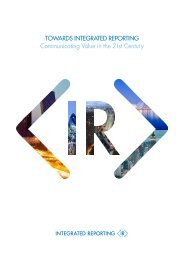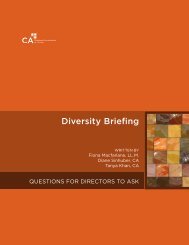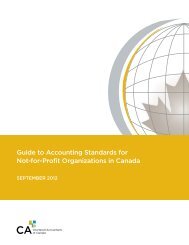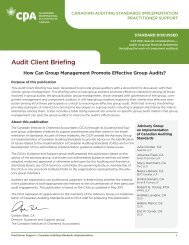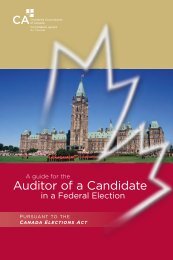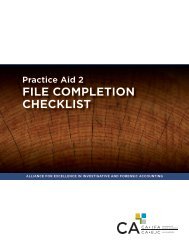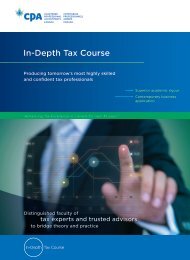20 Questions Directors of Not-for-Profit Organizations Should Ask ...
20 Questions Directors of Not-for-Profit Organizations Should Ask ...
20 Questions Directors of Not-for-Profit Organizations Should Ask ...
You also want an ePaper? Increase the reach of your titles
YUMPU automatically turns print PDFs into web optimized ePapers that Google loves.
Individual directors<br />
Board members participate in the assessments as<br />
individuals by providing in<strong>for</strong>mation and opinions<br />
on the effectiveness <strong>of</strong> the board, its committees<br />
and chairs, as well as their own per<strong>for</strong>mance and<br />
that <strong>of</strong> their fellow directors. After the assessment,<br />
they respond to feedback on their per<strong>for</strong>mance and<br />
identify and act on opportunities <strong>for</strong> improvement.<br />
As noted earlier, there may be opportunities <strong>for</strong><br />
directors to reflect on their per<strong>for</strong>mance through a<br />
self-assessment questionnaire. For these to be most<br />
effective, there should be some sort <strong>of</strong> follow-up,<br />
either a discussion with the chair or a general board<br />
discussion regarding what was learned.<br />
Who <strong>Should</strong> Lead the Board Evaluation<br />
The board evaluation should be designed to<br />
identify key difficulties. If the board is ineffective,<br />
the chair is the greatest influence on this.<br />
Ideally, the board chair should not lead the<br />
board evaluation, administer questionnaires or<br />
interview directors.<br />
However, this does not mean that the chair<br />
should not debrief with individual directors on<br />
the results <strong>of</strong> the assessment.<br />
The governance committee<br />
The chair <strong>of</strong> the governance committee (or its<br />
equivalent), should be responsible <strong>for</strong> leading the<br />
assessment process. The governance committee<br />
may conduct the assessment tasks or delegate<br />
some or all <strong>of</strong> them to a third party consultant or,<br />
as appropriate, a staff member. The governance<br />
committee is responsible <strong>for</strong> the design and<br />
conduct <strong>of</strong> the assessment and the questionnaires,<br />
interviews and related activities. It is also<br />
responsible <strong>for</strong> coordinating the summarization,<br />
analysis and reporting <strong>of</strong> the results <strong>of</strong> the<br />
assessments to the board and the feedback on<br />
per<strong>for</strong>mance to individual directors and chairs.<br />
Alternatively, if a governance committee does not<br />
exist, the board may act as a committee <strong>of</strong> the<br />
whole under the leadership <strong>of</strong> a director other<br />
than the board chair or CEO.<br />
14. What techniques and support may be<br />
used when conducting an assessment<br />
The principal techniques <strong>for</strong> collecting and<br />
compiling assessment in<strong>for</strong>mation include<br />
questionnaires and interviews.<br />
A questionnaire (or survey) should ensure that<br />
the full range <strong>of</strong> effectiveness issues is assessed<br />
and that the right questions are asked in order<br />
to surface key issues and reflect best practices.<br />
Surveys should contain a combination <strong>of</strong><br />
quantitative scoring metrics, and also provide the<br />
opportunity <strong>for</strong> directors to provide qualitative<br />
verbal commentary to contribute background<br />
and context to quantitative scores. The verbal<br />
commentary should not be attributed in order to<br />
preserve anonymity but may be summarized.<br />
The two most common approaches to qualitative<br />
analysis are interviews and direct observations; the<br />
<strong>for</strong>mer being far more prevalent.<br />
360 Degree Assessments<br />
In a “360 degree assessment”, the board, its<br />
committees and individual directors are assessed<br />
by board members and others, such as reporting<br />
staff, using a confidential survey.<br />
An interview can be structured or free-flowing, and<br />
can create a powerful dynamic if done properly.<br />
Interviews may be conducted by the chair <strong>of</strong> the<br />
governance committee, board chair or an external<br />
governance adviser. These conversations may<br />
provide greater candour and be more effective in<br />
addressing sensitive issues than a questionnaire,<br />
particularly interviews conducted by a third party<br />
where anonymity is assured. An interview can also<br />
be more collective in nature, such as a facilitated<br />
group discussion with the board.<br />
“We get these standardized <strong>for</strong>ms — 10 or 12 pages,<br />
and you check, check, check… We have got to do<br />
something about the evaluation process. They have<br />
to be better. They have to be tougher.”<br />
Pr<strong>of</strong>essional director, having served on<br />
approximately 30 boards.<br />
18





